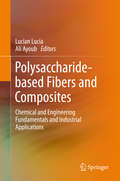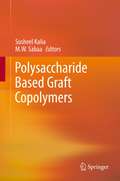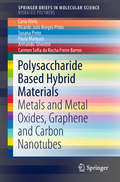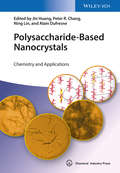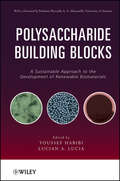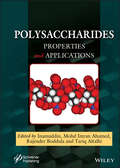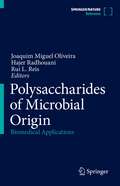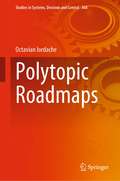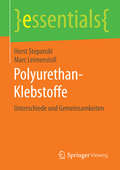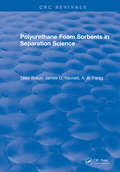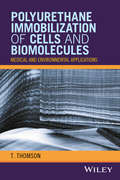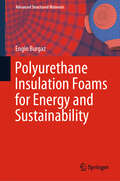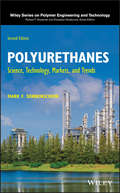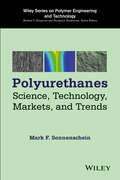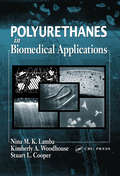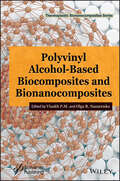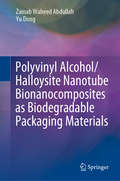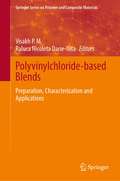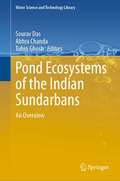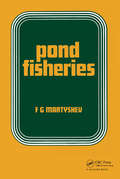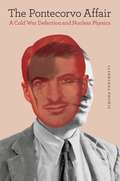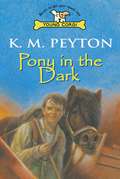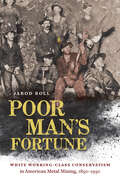- Table View
- List View
Polysaccharide-based Fibers and Composites
by Lucian Lucia Ali AyoubThis book includes chapters based on the potential uses of polysaccharides such as fibers in food and non-food applications. The complexity of their synthesis in plants, the highly multidisciplinary character of polysaccharide research, and the wide variety of applications from food to clothing to energy are addressed in this volume. The authors describe in detail how these latter grand challenges are of great importance in research, especially in the midst of enormous overpopulation and economic issues. Therefore, the volume contributes additional information to the chemical, nutritional, medical, and energy roles of these bio-based products, finding applications in diverse fields of their raw and composite forms. This volume is a useful resource for graduate students and contains themes for instructors and senior research leaders. Written by internationally renowned experts, it is aimed at workers in polymer laboratories, classrooms, and policy makers.
Polysaccharide Based Graft Copolymers
by Susheel Kalia M. W. SabaaRenowned experts give all essential aspects of the techniques and applications of graft copolymers based on polysaccharides. Polysaccharides are the most abundant natural organic materials and polysaccharide based graft copolymers are of great importance and widely used in various fields. Natural polysaccharides have recently received more attention due to their advantages over synthetic polymers by being non-toxic, biodegradable and available at low cost. Modification of polysaccharides through graft copolymerization improves the properties of polysaccharides. Grafting is known to improve the characteristic properties of the backbones. Such properties include water repellency, thermal stability, flame resistance, dye-ability and resistance towards acid-base attack and abrasion. Polysaccharides and their graft copolymers find extensive applications in diversified fields. Applications of modified polysaccharides include drug delivery devices, controlled release of fungicides, selective water absorption from oil-water emulsions, purification of water etc.
Polysaccharide Based Hybrid Materials: Metals and Metal Oxides, Graphene and Carbon Nanotubes (SpringerBriefs in Molecular Science)
by Carla Vilela Ricardo João Pinto Susana Pinto Paula Marques Armando Silvestre Carmen Sofia da Rocha Freire BarrosThis brief explores polysaccharides, the most abundant family of naturally occurring polymers, and explains how they have gained considerable attention in recent decades as a source of innovative bio-based materials. The authors present a range of material including an extensive array of polysaccharide hybrid nanomaterials with distinct applications. The most recent knowledge regarding polysaccharide-based hybrid nanomaterials with metal and metal oxide nanoparticles (NPs), carbon nanotubes and graphene is presented as well as the main polysaccharides, namely cellulose, chitin and chitosan, starch and their most relevant derivatives. The book features a description of important production methodologies, properties, and applications of these types of hybrids.
Polysaccharide-Based Nanocrystals: Chemistry and Applications
by Jin Huang Peter R. Chang Ning Lin Alain DufresnePolysaccharide nanocrystals, an emerging green nanoingredient (nanomaterial) with high crystallinity obtained by acid hydrolysis of biomass-based polysaccharides, are of scientific and economic significance owing to their abundance, biodegradation potential, and fascinating functional performance. This versatile class of materials can be used in nanocomposites such as rubber or polyester, and in functional materials such as drug carriers, bio-inspired mechanically adaptive materials or membranes, to name but a few. This book encompasses the extraction, structure, properties, surface modification, theory, and mechanism of diverse functional systems derived from polysaccharide nanocrystals. This highly sought-after trendy book is currently the only monograph devoted to the most current knowledge pertaining to this exciting subject area. It is ideal for researchers and stakeholders who wish to broaden and deepen their knowledge in the fast-moving and rapidly expanding R&D field of polymeric materials.
Polysaccharide Building Blocks
by Youssef Habibi Lucian A. LuciaThis book is an archival reference for the evolving field of biomaterials and their applications in society, focusing on their composition, properties, characterization, chemistry and applications in bioenergy, chemicals, and novel materials and biomaterials. It has broad appeal due to the recent heightened awareness around bioenergy and biomass as potential replacements for petroleum feedstocks. The book is divided into three parts: cellulose-based biomaterials, chitin and chitosan biomaterials, and hemicelluloses and other polysaccharides. Each chapter addresses a separate biomaterial, discussing its chemical, physical, and biological attributes, and hones in on each compound's intrinsic tunability for numerous chemical transformations. In the current quest for a "green" economy and resources, this book will help inspire scientists towards novel sources for chemicals, materials, and energy in the years to come.
Polysaccharides: Properties and Applications
by Inamuddin Mohd Imran Ahamed Rajender Boddula Tariq AltalhiThis book provides the whole spectrum of polysaccharides from basic concepts to commercial market applications. Chapters cover various types of sources, classification, properties, characterization, processing, rheology and fabrication of polysaccharide-based materials and their composites and gels. The applications of polysaccharides include in cosmetics, food science, drug delivery, biomedicine, biofuel production, marine, packaging, chromatography and environmental remediation. It also reviews the fabrication of inorganic and carbon nanomaterials from polysaccharides. The book incorporates industrial applications and will fill the gap between the exploration works in the laboratory and viable applications in related ventures.
Polysaccharides of Microbial Origin: Biomedical Applications
by Rui L. Reis Joaquim Miguel Oliveira Hajer RadhouaniThis book provides a comprehensive analysis of microbial polysaccharides, their current uses, and highlights biomedical opportunities. The topics comprise principally a) their extraction, isolation, purification and advanced production processes; b) characterization of their structural, physicochemical, and biological properties, among others, by several techniques; c) description of the advanced functionalization and modification methods for the polysaccharide based-material; and d) their applications and uses in medical and pharmaceutical fields. Each chapter is written by world-renowned academics and practitioners on their field. This is an essential reference for students in biomedical, chemical, material, and microbiology engineering as well as researchers and professionals in the medical field.
Polytopic Roadmaps (Studies in Systems, Decision and Control #368)
by Octavian IordacheThis book is useful to engineers, researchers, entrepreneurs, and students in different branches of production, engineering, and systems sciences. The polytopic roadmaps are the guidelines inspired by the development stages of cognitive-intelligent systems, and expected to become powerful instruments releasing an abundance of new capabilities and structures for complex engineering systems implementation. The 4D approach developed in previous monographs and correlated with industry 4.0and Fourth Industrial Revolution is continued here toward higher dimensions approaches correlated with polytopic operations, equipment, technologies, industries, and societies. Methodology emphasizes the role of doubling, iteration, dimensionality, and cyclicality around the center, of periodic tables and of conservative and exploratory strategies. Partitions, permutations, classifications, and complexification, as polytopic chemistry, are the elementary operations analyzed. Multi-scale transfer, cyclic operations, conveyors, and assembly lines are the practical examples of operations and equipment. Polytopic flow sheets, online analytical processing, polytopic engineering designs, and reality-inspired engineering are presented. Innovative concepts such as Industry 5.0, polytopic industry, Society 5.0, polytopic society, cyber physical social systems, industrial Internet, and digital twins have been discussed. The general polytopic roadmaps, (GPTR), are proposed as universal guidelines and as common methodologies to synthesize the systemic thinking and capabilities for growing complexity projects implementation.
Polyurethan-Klebstoffe: Unterschiede und Gemeinsamkeiten (essentials)
by Horst Stepanski Marc LeimenstollDie Autoren zeigen anschaulich dieunterschiedlichen chemischen Zusammensetzungen der verschiedenen Arten vonPolyurethan-Klebstoffen und welche Gemeinsamkeiten diese andererseits haben. Dadurchmöchten die Autoren mehr Verständnis für die Breite der Möglichkeiten wecken,die der reich bestückte Baukasten der Polyurethan-Chemie denKlebstoff-Formulierern bietet. Dies erleichtert angesichts sich wandelndertechnologischer Anforderungen die Kommunikation zwischen Klebstoffanwendern und-herstellern.
Polyurethane Foam Sorbents in Separation Science
by BraunThe purpose of this book is to present in a monographic and systematised form a review of all the literature devoted to polyurethane-based polymeric sorbents in separation chemistry. The primary types of sorbents dealt with are polyurethane foams and open-pore polyurethanes. The structure of the monograph follows this dichotomy. A book of this nature should stimulate thinking and incite its reader to consult the original literature. It will, however, not make such a consultation superfluous. A fair amount of the results described in this monograph constitute the main activity of investigation which took place in the authors laboratories during the past decade.
Polyurethane Immobilization of Cells and Biomolecules: Medical and Environmental Applications
by T. ThomsonThis book provides a comprehensive review of the chemistry and research illustrating the benefits of polyurethane for immobilizing cells, with dozens of case studies in medical devices and environmental engineering.• Offers an essential resource for medical and environmental scientists• Provides a multidisciplinary and lucid writing style that uses little or no jargon• Extrapolates current technology into advanced areas, especially environmental remediation and medical devices• Fills the gap between immobilization research and practical applications
Polyurethane Insulation Foams for Energy and Sustainability (Advanced Structured Materials #111)
by Engin BurgazThis review book focuses on the structure-property relationships of polyurethane nanocomposite foams in comparison with those of conventional polyurethane composite foams. The thermal insulation properties of polyurethane foam nanocomposites are discussed along with other traits such as their morphology, mechanical and thermomechanical properties, thermal degradation and flammability, energy absorption and saving capability, recycling and recovery behavior. In turn, the book discusses potential applications of PU nanocomposite foams and outlines the main problems that remain to be solved with regard to this important topic.
Polyurethanes: Science, Technology, Markets, and Trends (Wiley Series on Polymer Engineering and Technology)
by Mark F. SonnenscheinThis book, cohesively written by an expert author with supreme breadth and depth of perspective on polyurethanes, provides a comprehensive overview of all aspects of the science and technology on one of the most commonly produced plastics. Covers the applications, manufacture, and markets for polyurethanes, and discusses analytical methods, reaction mechanisms, morphology, and synthetic routes Provides an up-to-date view of the current markets and trend analysis based on patent activity and updates chapters to include new research Includes two new chapters on PU recycling and PU hybrids, covering the opportunities and challenges in both
Polyurethanes
by Mark F. SonnenscheinA complete overview of a key plasticOne of the most versatile polymer materials, polyurethanes have a unique chemical nature that allows for shaping and molding to fit all sorts of consumer and industrial products - seat cushions, carpets, insulation, coatings, and refrigerators to name a few. Despite its popular uses, polyurethane science has only relatively recently achieved appreciation for the richness of its expression as a polymer family. This book provides a thorough presentation of polyurethane science, technology markets and trend analysis based on recent patents. Although it does not provide ultimate detail (such as explicit information typically in patents), the book has a flow and continuity that allows readers to find all the background necessary to understand any other more detailed polyurethane information found elsewhere.Anyone involved in the polymer and plastics industry will find this book a key resource with features that include:An in-depth summary of the current state of polyurethane research and knowledgeDiscussion of the applications, manufacture, and markets for polyurethanesAnalytical methods, reaction mechanisms, morphology, theoretical techniques, and the selection of chain extendersPolyurethane flexible and rigid foams, elastomers, coatings, adhesives, and medical applicationsIn-depth coverage of governmental regulations, non-isocyanate/non-phosgene routes to polyurethane structure, and industrial routes to environmental, health, and safety risk mitigation
Polyurethanes in Biomedical Applications
by NinaM.K. LambaPolyurethanes in Biomedical Applications studies the use of polyurethanes in implanted medical devices. This analysis describes the concepts of polymer science, the manufacture of polyurethanes, and the biological responses to implant polyurethanes, reflecting the developments in biomaterials science and the interdisciplinary nature of bioengineering.
Polyvinyl Alcohol-Based Biocomposites and Bionanocomposites
by Visakh P. M. Olga B. NazarenkoPolyvinyl Alcohol-Based Biocomposites and Bionanocomposites Serves as a one-stop reference resource for important research accomplishments in the area of polyvinyl alcohol-based biocomposites and bionanocomposites. Many recent research accomplishments in the area of polyvinyl alcohol (PVA)-based biocomposites and bionanocomposites are summarized in this book. In it, the editors discuss as many topics as possible on the most recent state-of-the-art developments regarding these biocomposites and bionanocomposites, the challenges faced when using them, and their future prospects. In addition to providing a biodegradation study of them, their significance and applications are also discussed, along with practical steps toward their commercialization. Moreover, PVA/cellulose-based and PVA/starch-based biocomposites and bionanocomposites are discussed, along with the biomedical applications of PVA-based composites and nanocomposites, and PVA-based hybrid interpolymeric complexes and their applications. Audience This book will be a very valuable reference source for polymer researchers, materials scientists, biochemists, engineers, graduate and postgraduate students working on polymers, composites, and nanocomposites, especially in the area of polyvinyl alcohol-based bionanocomposites.
Polyvinyl Alcohol/Halloysite Nanotube Bionanocomposites as Biodegradable Packaging Materials
by Zainab Waheed Abdullah Yu DongThis book focuses on the preparation and characterisation of polyvinyl alcohol (PVA)/ halloysite nanotube (HNT) bionanocomposite films with different HNT contents for potential use in food packaging. It examines the effect of material composition and nanofiller content on mechanical, thermal and optical properties in relation to their morphological structures, and also comprehensively describes the water resistance, biodegradation and migration rates of such bionanocomposites, as well as their barrier properties in terms of water vapour transmission, and water vapour, air and oxygen permeabilities. Further, this book discusses the use of Nielsen model and Cussler model to predict the relative permeability of bionanocomposites, demonstrating that Nielsen model is more effective and in better agreement with experimental data obtained. Lastly, it discusses the application of bionanocomposite films in food packaging to prolong the shelf life of freshly cut avocados and peaches.
Polyvinylchloride-based Blends: Preparation, Characterization and Applications (Springer Series on Polymer and Composite Materials)
by Visakh P. M. Raluca Nicoleta Darie-NitaThis book summarizes many of the recent research accomplishments in the area of polyvinylchloride (PVC)-based blends and their preparation, characterization and applications. Various sub-topics are addressed, such as the state-of-the-art of PVC based blends, new challenges and opportunities, emphasis being given to the types and sizes of components/fillers and optimum compositions of PVC blends, their processing and structure-properties relationships, modification/compatibilization methods, and possible applications. PVC/thermoplastic based nano, micro and macro blends, PVC membranes, bio-based plasticizers and PVC blends with components from renewable resources are reported. The various chapters in this book are contributed by prominent researchers from industry, academia and government/private research laboratories across the globe. It covers an up-to-date record on the major findings and observations in the field of PVC-based blends.
Pond Ecosystems of the Indian Sundarbans: An Overview (Water Science and Technology Library #112)
by Tuhin Ghosh Sourav Das Abhra ChandaThis book aims to give a holistic overview of the pond ecosystem of Indian Sundarbans. Due to climate change, the Indian Sundarbans faces several challenges. With rising sea levels, islands are disappearing and the increasing salinity in the water and soil has severely threatened the health of mangrove forests and the quality of fresh water, soil and crops. Additionally, there have been serious disturbances to hydrological parameters in the lotic as well lentic ecosystems.This book provides new insights into lentic ecosystem-oriented research in the deltaic ecosystem of GBM-I (Ganga-Brahmaputra-Meghna, Indian Delta). The major findings from various research works are brought together, and the gaps and future possible ways forward are outlined. The book addresses the SDG 6 (Clean Water and Sanitation), SDG 13 (Climate Action) and SDG 14 (Life below Water), with a focus on the ecosystem services of ponds in the Indian Sundarbans.Despite there being many studies on riverine water, ground water and mangrove ecosystems of the Indian Sundarbans, this book offers new insights into the pond ecosystem of the Indian Sundarbans. The outcomes from this book can be utilized by researchers from the inland fisheries sector, environmental managers, professionals, and those who seek to develop ways for making pond ecosystems sustainable.
Pond Fisheries
by F. MartyshevA comprehensive study of pond fisheries. Topics include the organisation and construction of fish ponds, production processes in fish farms for warmwater carp and cold-water trout, and irrigation networks and reservoirs constructed for multipurpose exploitation.
The Pontecorvo Affair: A Cold War Defection and Nuclear Physics
by Simone TurchettiIn the fall of 1950, newspapers around the world reported that the Italian-born nuclear physicist Bruno Pontecorvo and his family had mysteriously disappeared while returning to Britain from a holiday trip. Because Pontecorvo was known to be an expert working for the UK Atomic Energy Research Establishment, this raised immediate concern for the safety of atomic secrets, especially when it became known in the following months that he had defected to the Soviet Union. Was Pontecorvo a spy? Did he know and pass sensitive information about the bomb to Soviet experts? At the time, nuclear scientists, security personnel, Western government officials, and journalists assessed the case, but their efforts were inconclusive and speculations quickly turned to silence. In the years since, some have downplayed Pontecorvo's knowledge of atomic weaponry, while others have claimed him as part of a spy ring that infiltrated the Manhattan Project. The Pontecorvo Affair draws from newly disclosed sources to challenge previous attempts to solve the case, offering a balanced and well-documented account of Pontecorvo, his activities, and his possible motivations for defecting. Along the way, Simone Turchetti reconsiders the place of nuclear physics and nuclear physicists in the twentieth century and reveals that as the discipline's promise of military and industrial uses came to the fore, so did the enforcement of new secrecy provisions on the few experts in the world specializing in its application.
The Pontecorvo Affair: A Cold War Defection and Nuclear Physics
by Simone TurchettiIn the fall of 1950, newspapers around the world reported that the Italian-born nuclear physicist Bruno Pontecorvo and his family had mysteriously disappeared while returning to Britain from a holiday trip. Because Pontecorvo was known to be an expert working for the UK Atomic Energy Research Establishment, this raised immediate concern for the safety of atomic secrets, especially when it became known in the following months that he had defected to the Soviet Union. Was Pontecorvo a spy? Did he know and pass sensitive information about the bomb to Soviet experts? At the time, nuclear scientists, security personnel, Western government officials, and journalists assessed the case, but their efforts were inconclusive and speculations quickly turned to silence. In the years since, some have downplayed Pontecorvo’s knowledge of atomic weaponry, while others have claimed him as part of a spy ring that infiltrated the Manhattan Project. The Pontecorvo Affair draws from newly disclosed sources to challenge previous attempts to solve the case, offering a balanced and well-documented account of Pontecorvo, his activities, and his possible motivations for defecting. Along the way, Simone Turchetti reconsiders the place of nuclear physics and nuclear physicists in the twentieth century and reveals that as the discipline’s promise of military and industrial uses came to the fore, so did the enforcement of new secrecy provisions on the few experts in the world specializing in its application.
Pony in the Dark
by K. M. PeytonWhen Tom's favorite Shetland pony, Storm, is sold to work in the coal mines, he is devastated. The poor little black pony will have to work underground for the rest of his life - never seeing the sky or breathing fresh air! And when there is a terrible accident in the mine, Tom wonders whether he'll ever be with Storm again. A heart-warming story from an award-winning author.
Poor Man's Fortune: White Working-Class Conservatism in American Metal Mining, 1850–1950
by Jarod RollWhite working-class conservatives have played a decisive role in American history, particularly in their opposition to social justice movements, radical critiques of capitalism, and government help for the poor and sick. While this pattern is largely seen as a post-1960s development, Poor Man's Fortune tells a different story, excavating the long history of white working-class conservatism in the century from the Civil War to World War II. With a close study of metal miners in the Tri-State district of Kansas, Missouri, and Oklahoma, Jarod Roll reveals why successive generations of white, native-born men willingly and repeatedly opposed labor unions and government-led health and safety reforms, even during the New Deal. With painstaking research, Roll shows how the miners' choices reflected a deep-seated, durable belief that hard-working American white men could prosper under capitalism, and exposes the grim costs of this view for these men and their communities, for organized labor, and for political movements seeking a more just and secure society. Roll's story shows how American inequalities are in part the result of a white working-class conservative tradition driven by grassroots assertions of racial, gendered, and national privilege.
Poor Man's Fortune: White Working-Class Conservatism in American Metal Mining, 1850–1950
by Jarod RollWhite working-class conservatives have played a decisive role in American history, particularly in their opposition to social justice movements, radical critiques of capitalism, and government help for the poor and sick. While this pattern is largely seen as a post-1960s development, Poor Man's Fortune tells a different story, excavating the long history of white working-class conservatism in the century from the Civil War to World War II. With a close study of metal miners in the Tri-State district of Kansas, Missouri, and Oklahoma, Jarod Roll reveals why successive generations of white, native-born men willingly and repeatedly opposed labor unions and government-led health and safety reforms, even during the New Deal. With painstaking research, Roll shows how the miners' choices reflected a deep-seated, durable belief that hard-working American white men could prosper under capitalism, and exposes the grim costs of this view for these men and their communities, for organized labor, and for political movements seeking a more just and secure society. Roll's story shows how American inequalities are in part the result of a white working-class conservative tradition driven by grassroots assertions of racial, gendered, and national privilege.
